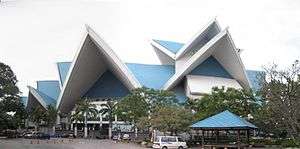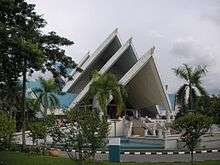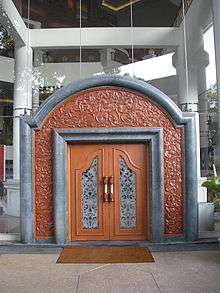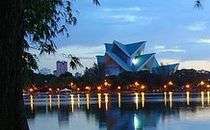Istana Budaya
Coordinates: 3°08′N 101°42′E / 3.133°N 101.700°E

The Istana Budaya (literally The Palace of Culture), founded in September 1999, is Malaysia's main venue for all types of theatre including musical theatre, operetta, classical concert and opera from local and international performances. It is located next to the National Art Gallery on Jalan Tun Razak in the heart of Kuala Lumpur.
History


The idea of this state-of-the-art theatre began with the proposal in 1964 to establish a cultural centre. The construction work began in 1995 and was completed three years later. It was built at a cost of RM210 million with a theatre floor area of 21,000 m² as part of the 54,400 m² cultural complex. The Istana Budaya was officially opened by the former Prime Minister of Malaysia, Tun Dr. Mahathir Mohamad in 1999.
The Istana Budaya theatre hall Panggung Sari, with its unique design of royal boxes inspired by the windows of the traditional Rumah Melayu or Malay house, can accommodate up to 1,412 audiences at a time. The building is the first theatre in Asia that is equipped with state-of-the-art stage equipment. Istana Budaya is also rated among the ten most sophisticated theatres in the world, and on par with the Royal Albert Hall in London.[1]
Upon completion, the former national theatre, Panggung Negara was relocated to this new building. Istana Budaya is also the residence of the National Theatre Company and the National Symphony Orchestra.
Objective
Istana Budaya aims to raise the standards of performing arts, develop artistic excellence in theatre, popularise high-quality theatre productions and develop a higher sense of artistic appreciation.
Architecture

The building was designed by the local architect, Muhammad Kamar Ya'akub. The inspiration for the design is based on a traditional moon kite in flight.[2] The turquoise folds on the roof and the intricate design of the foyer are just two of the interesting features of the building. Istana Budaya’s architecture has intrigued experts and academics.
The main building takes the shape of the sirih junjung, a traditional arrangement or a present made of betel leaves used during Malay weddings and welcoming ceremonies. As in a traditional Malay house, the building is divided into three areas:
- The serambi (lobby and foyer)
- The rumah ibu (main house) as the auditorium
- The rumah dapur (kitchen) as the stage and rehearsal hall.
The interior was constructed using local resources such as Langkawi’s marble and high-quality tropical wood for the doors crafted by hand to shape flowers and leaf motifs. The verdant carpets in the entrance hall and lobby feature cempaka flower and the banyan tree, inspired by traditional Malay opera or Mak Yong.[3]
In the auditorium, there are royal boxes on each side, patterned after the windows of a Malay house. The entrance to the theatre, too, replicates a palace’s main hall, or the Balairong Seri and is said to be modelled after one in Malacca.
The theatre lobby on the third floor extends the influence of Malay culture, taking the shape of the rebana ubi or traditional drum. The auditorium itself seats about 1,412 people, including 797 in the stalls on the first floor, 312 in the grand circle on the second floor and 303 people in the upper circle. The orchestra pit, when it is not in use, can take in 98 people.
While there seems to be a large number of stairs, the disabled can take heart. Istana Budaya has wheelchair facilities, including a ramp into the foyer, a lift with easy-to-reach buttons and an area designated for the handicapped. Restrooms for the disabled are also found at both the stalls and grand circle areas. Additionally, there is also a costume gallery featuring clothes from Malay traditional theatre. The costumes are from Bangsawan, Mak Yong, Ajat Bebunuh, Layang Emas and Bambarayon performances, among others.
Performances
Until today, although not often, the Istana Budaya has staged notable productions of such operas as The Merry Widow, Tosca, La Bohème, Turandot, Carmen and many more accompanied by the National Symphony Orchestra and Choir.
Among the more successful local productions staged here was Puteri Gunung Ledang - The Musical, which opened to full house on almost all nights.
Dato' Siti Nurhaliza, widely considered the princess of Malaysian pop, is also noted to have held a full-house concert here.
Principal conductors
- Mustafa Fuzer Nawi (1999 - ) Conductor/Music Director
See also
References
- ↑ "Istana Budaya". Retrieved 3 July 2007.
- ↑ "Istana Budaya". Retrieved 3 July 2007.
- ↑ Interior designRetrieved 3 July 2007. Archived August 20, 2007, at the Wayback Machine.
External links
| Wikimedia Commons has media related to Istana Budaya. |
- Istana Budaya Official website
- The history of Istana Budaya
- Tourism Malaysia - Istana Budaya
- Malaysian Philharmonic hall and orchestra
- All about Malaysia - Istana Budaya
- Ranked among the world’s premier theaters
- Malaysian Property Partners - The Palace of Culture
